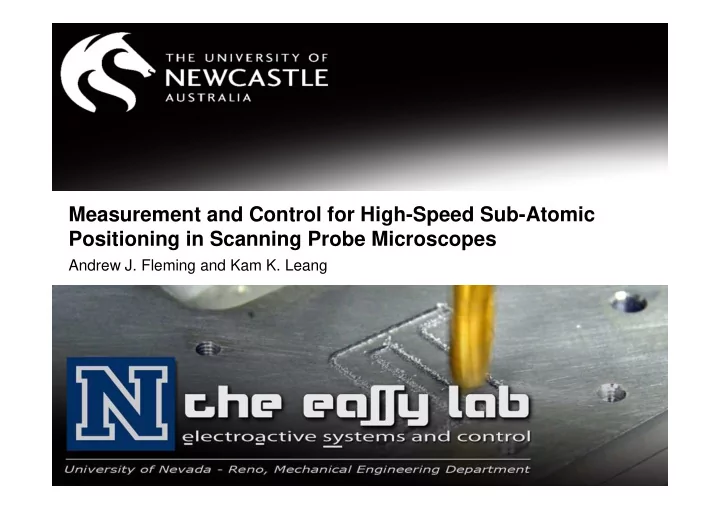

Measurement and Control for High-Speed Sub-Atomic Positioning in Scanning Probe Microscopes Andrew J. Fleming and Kam K. Leang
Outline • Challenges and benefits of feedforward control • System inversion – Linear dynamics (creep and vibration) – Nonlinearity (hysteresis) • Iteration-based feedforward • Conclusions
Key challenges in SPMs using piezoelectric actuators 1
Positioning errors effect SPM imaging 2
Positioning errors effect SPM fabrication 3
The feedforward control concept “ Anticipates ” Benefits of feedforward control • High-bandwidth positioning (compensates for lag) • Small tracking error with good models • Stable • Cost effective (no sensors for feedback) 4
Hammerstein-based model for piezoactuators Piezoelectric actuators 5
What’s the ‘best’ approach?
A1. Model and invert all effects Linear Nonlinear • Creep + Vibration • Hysteresis • Short-range • Long-range • Low-to-high speed • Low-speed Short-range, low/high-speed Long-range, low-speed 7
Short-range, low- and high-speed Vibration model Creep model 8
Inversion-based feedforward control: time domain 9
(Exact Inversion) Find input subject to the cost: 10
High-speed AFM imaging example Range: 10 x 10 x 2 µ m Resonances: 25 kHz (x), 6 kHz (y), >80 kHz (z) AFM imaging rate: >70 fps (100x100 pixels) 11 w/o FF w/ FF w/FF
12
Prandtl-Ishlinskii hysteresis model Sum of basic relays Hysteresis curve: Play operator 13
Advantages of relay-based hysteresis models • Inverse model can be obtained from measured input/output data Can be use for real-time feedforward control • 1 Hz 14
Loop due to phase shift 15
Creep, hysteresis, and vibration compensation Advantage: offers best performance with good models •Croft et. al., Creep, Hysteresis, and Vibration Compensation for Piezoactuators: Atomic Force Microscopy Application, 16 • ASME J. Dyn. Sys. Meas. Cont., 2001
A2. Model and invert G(j ω ), use feedback for H Advantage: avoids modeling nonlinearity 17
B1. What if you don’t know the model? Iteratively find the feedforward input Advantages • D oes not require an accurate model • Provides high-precision tracking • Can be automated, but requires a sensor • Stable 18
Types of update laws: time-domain 1. System is linear 1 2. System is hysteretic 2 1 Arimoto et. al., 1983; 2 Leang and Devasia, 2006 19
Frequency domain* * Wu et. al., 2007 20
AFM imaging example 1 Hz scanning; 100 iterations 21
Conclusions • Feedforward control anticipates for deficit performance • Feedforward control provides high-bandwidth, high-precision positioning (compensates for lag) with good models • Feedforward-controlled system is stable • Feedforward control does not require sensors 22
Recommend
More recommend